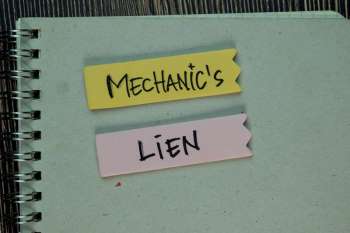- An encumbrance is an obligation or charge against a property
- Mortgages, tax liens, and mechanics liens are examples of common encumbrances
- Many encumbrances are satisfied and removed when the home is sold
- Easements and deed restrictions typically transfer with the sale of the property
Get an as-is cash offer for your home
"*" indicates required fields
If you’re buying or selling a home, you might be surprised to find the property has encumbrances. In this article, will examine encumbrances. We’ll look at when an encumbrance can and cannot be removed. Additionally, we’ll address how they might impact the sale of the property or the new owner.
What is an encumbrance?
According to Webster’s dictionary, an encumbrance is “a burden or charge upon an estate or property, so that it cannot be disposed of without being subject to it”. In simple terms, an encumbrance is a claim or obligation against the property. Most homes have encumbrances. These can be as simple as a mortgage on the home. The mortgage, creates a burden or obligation of the borrower to repay the lender for the the money they borrowed to purchase the home.
Examples of encumbrances
If you’re buying or selling a home, you’ll typically find encumbrances on the title report as title flaws. Your title report will list all of the obligations and encumbrances on the property in question. Common encumbrances are mortgages and tax liens for unpaid taxes. 
However, contractors may also place mechanics liens on a property for work the contractor has not been paid for. Mechanics liens may also come from suppliers and sub contractors your contractor used, that the contractor did not pay.
Solar companies will also place encumbrances on the property in the form of liens to protect their ownership of the equipment until your lease or purchase is complete.
Additionally, some programs help homeowners replace windows, roofs and HVAC systems with low monthly payments, but also place a lien on the property. These liens, are sometimes called “super liens” because they can have priority over other liens and may even survive in the event of foreclosure.
How do encumbrances affect your ownership?
It’s important to understand that encumbrances don’t prevent you from owning the property, using or enjoying your home. Instead, encumbrances guarantee that when a property is sold, or the ownership is transferred, that the lien holder is repaid. Your title company will use the title report to obtain a list of liens and encumbrances that need to be resolved, so they can transfer “clean title” to the new owner.
Where can I find a list of encumbrances against my home?
Encumbrances are public documents. That means they are recorded in the public records, typically at your local county office. When your title company searches for encumbrances on a property, they search the local government records. But you don’t need a title company to do this. You can personally go to your local public records office and do your own research for documents recorded against your property.
Can encumbrances be removed?
Most encumbrances are removed when a property is sold or ownership is changed. During the sale process, title company searches for encumbrances, and will pay any debts owed from the proceeds of the sale. Once the debt is paid, the encumbrances are removed.
Removing encumbrances without selling the home
Prior to the sale, some encumbrances can be removed by paying the debt and the lender filing paperwork with the public recorder’s office to remove the lien. For example, assume the homeowner failed to pay the contractor for work done and the contractor recorded a lien in the public records. Paying the contractor and getting a release of lien recorded in public records will remove the encumbrance.
Encumbrances that may not be removed
In rare cases, someone may purchase a home subject to an existing encumbrance. If you’re purchasing a home and assuming the existing mortgage, the existing mortgage will not be removed. If the home has a appurtenant (addressed next section) addition such as a solar panel lease, the solar panel lease will not be removed unless it has expired.
However some encumbrances such as easements, cannot be removed. Technically, these are not encumbrances, but rather appurtenances.
Easements and appurtenances
An appurtenance is something that is fixed or attached to the house, immovable and transfers with a property. For example, your HVAC unit is attached to the house and is considered part of the home. When the house sells, the HVAC unit and it’s benefits transfer to the new owner.
When it comes to your title report, there are some encumbrances that are attached to the property permanently and transfer to the new owner with the sale. Others, such as easements, are given to companies or utilities, and do not change with the sale.
Easements that change with the sale
If you and your neighbor share a driveway, you each may have an easement through a portion of your neighbor’s property. You have a right to drive your car down the driveway, even if the driveway is partly on your neighbor’s land. These easements, known as easement appurtenant, connect two different properties by assigning benefits to one or both properties. The easement is permanently attached to the deed of the property, and the rights transfer with the sale of the property to the new owner.
Easements that do not change with the sale
If you have utilities, such as power lines, water or sewer lines on your property, the utility companies have an easement. The easement grants the utility the right to go on your property to inspect and repair their equipment. Unlike an easement appurtenant, these rights do not transfer when a property sells. Only the owner of the property changes with the deed. The utility company continues to have the rights of the easement. Easements that do not transfer with the property sale, are called easements in gross.
Deed restrictions and CC&R’s
Deed restrictions are another form of an encumbrance that remain after a house is sold.
These restrictions are constraints that limit what you can do on or with your property. Deed restrictions often come in the form of Home Owners Associations (HOAs) and Covenants Conditions and Restrictions known as CC&Rs. A deed restriction may also limit the property to certain uses, such as low income households or only ownership by non profit groups.
HOAs
Home Owner Associations often have deed restrictions requiring your property to follow specific guidelines. These may include the colors you can paint your home, whether or not you can have cars in your driveway or the placement of fences around your yard. We’ve even seen HOA’s require all real estate for sale signs to use only the HOA approved color schemes and fonts. Some HOAs will also have additional dues for maintenance of areas owned or maintained by the community association. These might include pools and shared roads or utilities.
CC&Rs
If you’re purchasing a home with and deed restrictions, it’s important that you read the CC&Rs before purchasing the property. You’ll want to know what your limitations are with the property before you commit to your purchase. While you’re doing you due diligence, you’ll also want to talk to your agent, the seller and neighbors to determine if the CC&Rs are still enforced or in effect. You may also find that the CC&Rs are no longer in effect.
Conclusion
Encumbrances are obligations, sometimes called charges, that prevent a property from being transferred without their obligations being met. Not all encumbrances are financial. Some encumbrances, also called appurtenances, such a easements remain attached to the deed, even after the sale of the property. Deed restrictions such HOAs and CC&Rs, also remain attached to the property and may limit what a homeowner can do with their property.
